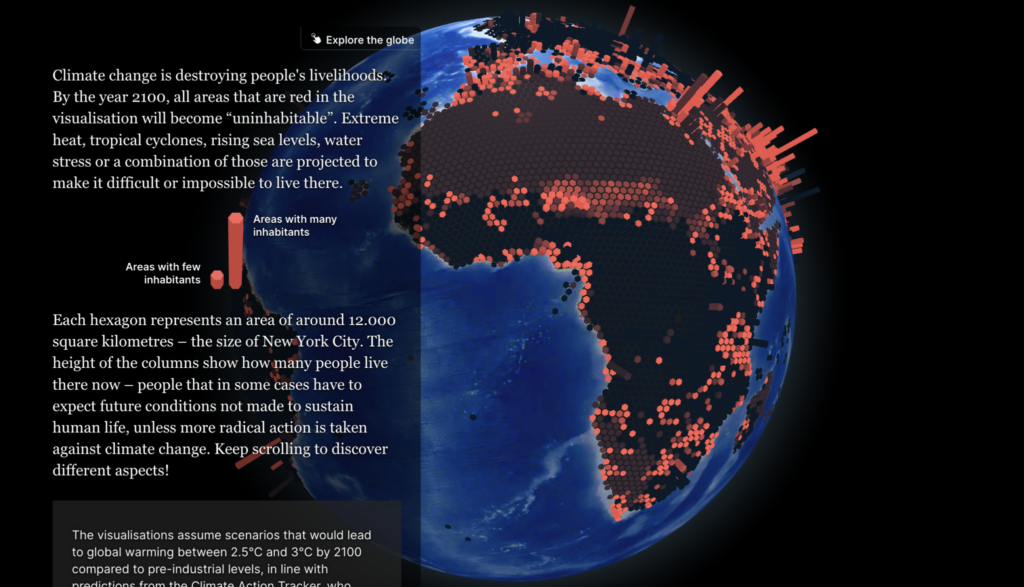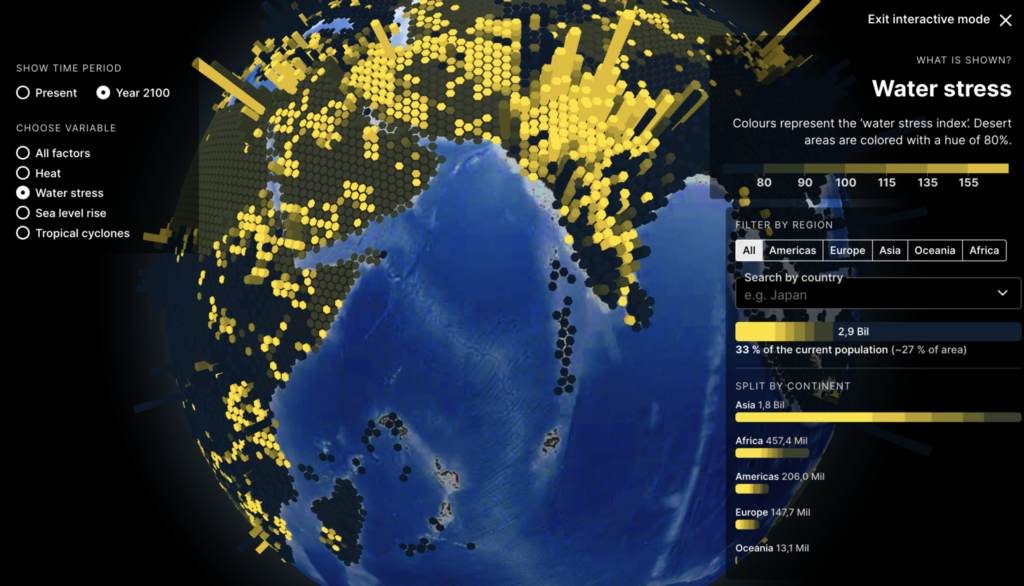The article Mapping where the earth will become uninhabitable is a data journalism piece that uses climate projection models to show areas around the globe which will become unlivable and the population which will be affected. The 3D interactive visualization uses different climate change issues (heat, floods, hurricanes, and water scarcity) with the data plotted on a map as colorful hexagons which represent an area of 12,000 square kilometers (the size of NYC). Because it is 3D visualization, the population affected is shown as the height of the hexagon. The purpose of this article is to educate and advocate for urgent action to be taken to mitigate catastrophic damage to these regions and populations.

I was particularly drawn this article because it is beautifully presented. It catches the reader’s eye. The bright colors of the globe contrasted on the black of space with hexagons protruding at varying heights is very attractive. It reminds me of what I would see at an exhibit at the Natural History Museum. Past the bright colors, it continues to draw the audience in via its scrollytelling format and provides an interactive exploration option for the readers to further engage. Through these methods the audience is hooked and will be more likely to consume the information.

Data visualizations are important for many reasons. One being they help the audience understand and see information in new ways. I believe people learn in different ways and providing different sources for consuming information is important to reach the public. This piece also includes a raw text link without a visualization if a consumer prefers a traditional article or does not have a web browser available. The article benefits a large audience and a wide range of ages and backgrounds. It presents information in an easily understood manner for those that may not be subject experts and it is written in a style that provides the essential information in small consumable pieces.
A few valuable factors of data journalism that this article includes are providing transparent data sources, data analysis that uncovers insights of the potential peril of populations, beautiful data visualizations to draw the reader in and audience engagement. But a critique of this article is that it does not take that extra step of and it appears to lack community engagement. Although it is providing consumable data for public awareness, it seems to stop at the point of only providing information without suggestions or resources for solutions. However, I did not investigate if this article was used past general education. Overall, the article was beautiful and insightfully provided information on a complex matter.



Hi Alex,
I was struck by this article as well, but it gave me pause for thought, as many of those most likely to be effected by the climate catastrophes in the future are unlikely to come across this data. Many communities with low rates of Internet access and digital literacy are on the list of those likely to be effected, and I see that the article is only available in English and (I’m assuming, the original) German.
While English is a huge language, and is considered the language of science, as Latin once was, the article is still not fully accessible to the billions of people who don’t speak, let alone read, English or German. I’d like to see such an important article in more languages than two.
There are only about 135 million worldwide German speakers, and around 1.45 billion English speakers, around a billion of whom do not speak English as their first language. Additionally, I have found that literacy rates even amongst English-as-a-first-language speakers are abysmal, with around 21 percent of US adults being functionally illiterate. I would also like to see more articles like this with play buttons, so that those who the public school system failed with its criminally negligent ways can also partake in the information provided.
Thank you for sharing this article. See my sources below.
Source for the Numbers on German and English Language Speakers: https://www.berlitz.com/blog/most-spoken-languages-world
Source for Literacy Data: https://nces.ed.gov/pubs2019/2019179/index.asp